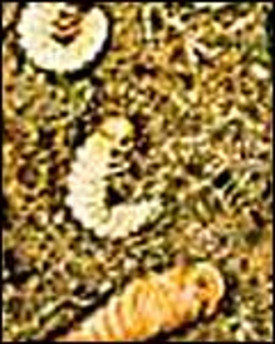 |
||
|
|
Japanese Beetles lay their eggs in midsummer. Their white grubs cause brown patches in August by eating grass roots. In different part of the United States, there are several other similar beetles (May beetles, June beetles and European chafers) whose grubs look almost the same and destroy lawns in the same way. In addition, deer ticks (which bite people and can spread Lyme disease) also hatch in August in the tall vegetation around the edges of lawns. Japanese Beetle Grubs are not a danger to humans, but are terrible predators of gardens, and especially lawns. They hatch in mid August, chew the grass roots until October, then hide deep in the ground until April when they come up and eat roots again through May. For a brief romantic period, the adults fly and mate in June and July, all the while devouring the loveliest of our flowers, especially roses and hollyhock.
Current theories of treatment for grubs are:
Maintain a healthy lawn. It can withstand some beetles grubs – up to 8 or 10 per square foot – without treatment. Check before you assume that brown patches are due to the fat, white C-shaped grubs. To test, cut and roll back a one foot square of lawn, and count the grubs. If you have fewer than 10, you don’t need any herbicides. Just fertilize around Labor Day, water as needed, and mow high 2 1/2 to 3 1/2 inches.
Before you use a pesticide, particularly strong chemicals on the lawn, remember that tests have shown that dogs and shoes bring large quantities into the house, especially onto carpets. Studies have shown that there are often far higher concentrations of chemicals on door mats than is allowed under EPA regulations on lawns.
 |
||
|
|
If you have Lots of Grubs, some Pesticides are:
Merit (Imadacloprid) is a new pesticide that has been tested recently with good results. It kills the grubs, though slowly. It is safer than most chemicals but takes time to work as it spreads slowly through the soil and then is taken up by the plants. However it lasts a long time. For control of grubs that hatch in August, it would have had to be applied in June. Read the directions for the right time of application and how to use it correctly.
Milky Spore Disease is a specific bT, also safer for humans than chemicals. It attacks only caterpillars and grubs. For lawns, it works best with a soil pH of 6.5 to 7 and a warmer climate (about from Long Island, New York south).
Nematodes are an exciting new control in our arsenal. These tiny worms that kill grubs have worked well in tests and should become a valuable pesticide. Originally, there were quality control problems; some nematodes need a special bacteria to work well and shipping can be a problem to get enough of them delivered alive and healthy. The big multi-national chemical company that had bought the rights to this research decided they were not cost effective and stopped production.
It is unfortunate that so many good things die for lack of preliminary research funding however, thankfully, university scientists are still doing the necessary research. Some organic catalogues still offer them, with newer batches and better results. Remember, nematodes need lots of water to work and August can be dry.
Use chemicals as a last resort. With the new environmental laws, the recommended chemicals change frequently. Consult your extension service or university for the current allowed chemicals. Most chemical companies sell old and new pesticides. Late summer is a good time to apply them to zap both grubs and ticks. Ideally apply them with fertilizer.
Japanese Beetle Traps should absolutely not be used within several hundred feet of your lawn and flowers. The mating scent, which smells like sickly sweet flowers, will attract beetles from far and wide. Your neighbors will love you.
Over seeding. If you want lots of nice green grass then always add grass seed in late August (in northern regions) and early fall (farther south). Mother Nature will make it grow all fall when weather temperatures are cooler. All the while, weeds and crab grass will be dying, providing space for the new seedlings.
Over seeding is easy. Just throw on some grass seed about Labor Day or later if you don’t get around to it. To improve the take, lightly rough up the soil surface, then step on the seeds or water them in for good soil-to-seed contact. In 5 days, with some water, perennial rye grass will have beautiful green sprouts. Fescue and bluegrass take 2-3 weeks.
If you love nice bright green grass, you are not alone. The Germans grow it plain and unmowed in decorative window boxes in the Alps. The Watusi herdsmen burn the vast African savannah to get new green grass for their cows. Seeds will grow for your children in a flowerpot or in a hollowed out potato filled with soil. For there is nothing so beautiful as bright green, fresh, young grass. It’s primordial.
Credit: Mother’s Garden




























